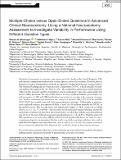Multiple-choice versus open‐ended questions in advanced clinical neuroanatomy : using a national neuroanatomy assessment to investigate variability in performance using different question types
Abstract
Methods of assessment in anatomy vary across medical schools in the United Kingdom (UK) and beyond; common methods include written, spotter, and oral assessment. However, there is limited research evaluating these methods in regards to student performance and perception. The National Undergraduate Neuroanatomy Competition (NUNC) is held annually for medical students throughout the UK. Prior to 2017, the competition asked open-ended questions (OEQ) in the anatomy spotter examination, and in subsequent years also asked single best answer (SBA) questions. The aim of this study is to assess medical students' performance on, and perception of, SBA and OEQ methods of assessment in a spotter style anatomy examination. Student examination performance was compared between OEQ (2013-2016) and SBA (2017-2020) for overall score and each neuroanatomical subtopic. Additionally, a questionnaire explored students' perceptions of SBAs. A total of 631 students attended the NUNC in the studied period. The average mark was significantly higher in SBAs compared to OEQs (60.6% vs. 43.1%, P <0.0001)-this was true for all neuroanatomical subtopics except the cerebellum. Students felt that they performed better on SBA than OEQs, and diencephalon was felt to be the most difficult neuroanatomical subtopic (n = 38, 34.8%). Students perceived SBA questions to be easier than OEQs and performed significantly better on them in a neuroanatomical spotter examination. Further work is needed to ascertain whether this result is replicable throughout anatomy education.
Citation
Merzougui , W H , Myers , M A , Hall , S , Elmansouri , A , Parker , R , Robson , A D , Kurn , O , Parrott , R , Geoghegan , K , Harrison , C H , Anbu , D , Dean , O & Border , S 2021 , ' Multiple-choice versus open‐ended questions in advanced clinical neuroanatomy : using a national neuroanatomy assessment to investigate variability in performance using different question types ' , Anatomical Sciences Education , vol. Early View . https://doi.org/10.1002/ase.2053
Publication
Anatomical Sciences Education
Status
Peer reviewed
ISSN
1935-9772Type
Journal article
Collections
Items in the St Andrews Research Repository are protected by copyright, with all rights reserved, unless otherwise indicated.

